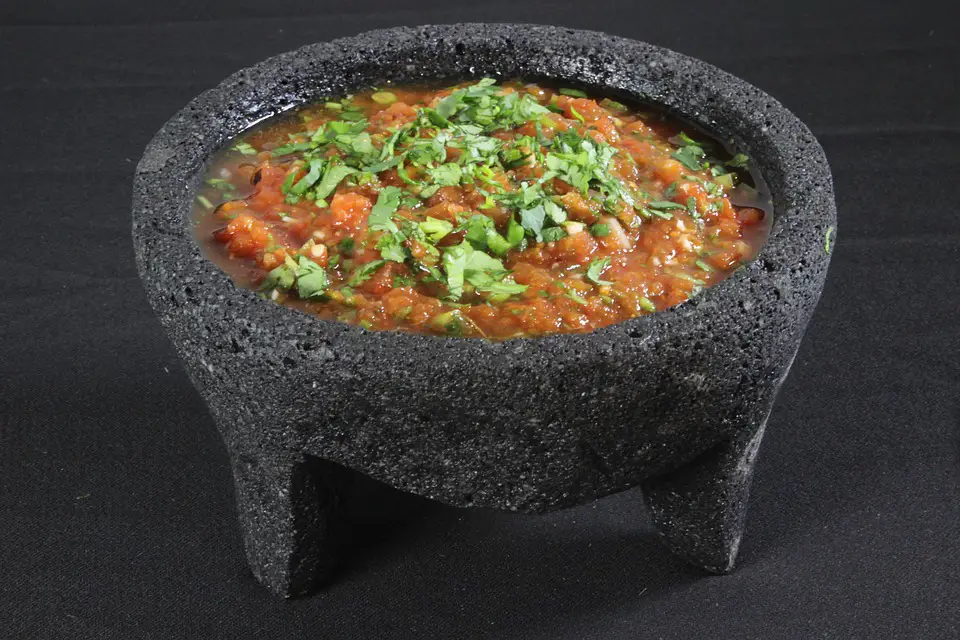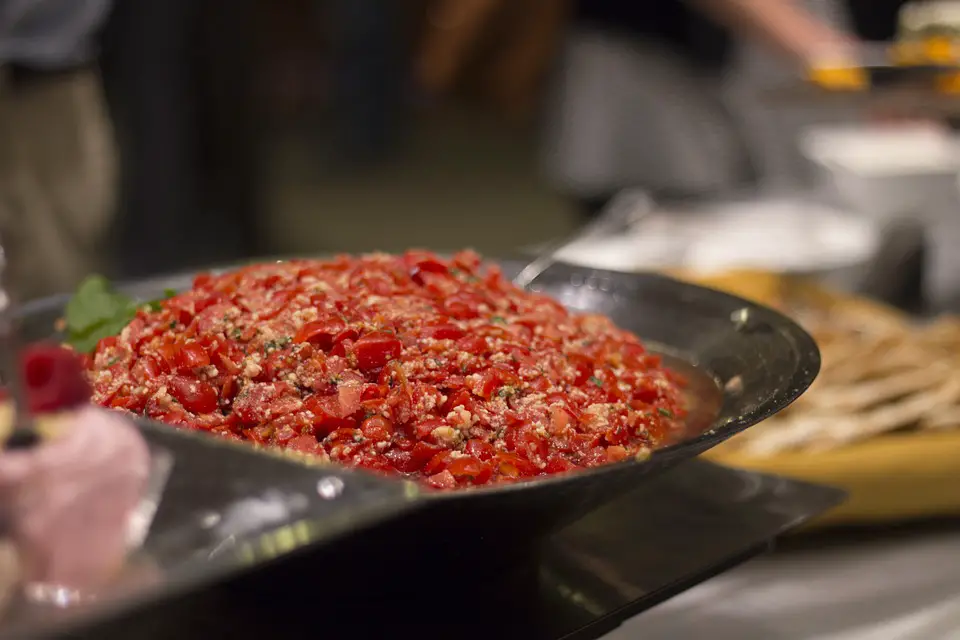Who is not a fan of salsa? In fact, you can add it to just about anything, not just tacos and nachos.
Despite being a functional food, a half-opened jar may occasionally remain in the refrigerator for several weeks or even months. Can salsa spoil?
There are countless options for store-bought salsa, and at least as many recipes exist for making your own. Most of the salsa jars are on the shelves, while a few are in the chilled aisle. Because of this, it’s simple to become perplexed about how to keep each type of salsa and how long it lasts.
We’ll review the most common choices in this post, where to store them, and how long they’re safe to eat. Continue reading to find out more about salsa.

What is Salsa?
Salsa may have only lately become popular among Americans, but its origins date back to ancient times, possibly even to the Aztec culture.
The word “salsa,” which means “sauce,” literally, refers to a range of dishes. Most Americans refer to a condiment composed of tomatoes, onions, and chiles when they use the word “salsa.”
The literal translation makes more sense as consumer demand for salsa rises. There are numerous sauces. Some include papaya, mango, plantains, corn, and other ingredients not commonly in salsa.
A balanced diet can benefit from the addition of salsa. The sauces have a low-calorie count and very little to no fat. Vitamins and minerals are contributed by several of the ingredients. Vitamins A and C are found in tomatoes, chilies, and cilantro.
How Long does Salsa Last in the Fridge?
Salsa’s shelf life is influenced by how it is made and distributed. One thing to bear in mind is that a lot of the ingredients in salsa are perishable. Salsa, in contrast to mustard or ketchup, won’t keep for very long after opening. Even if it is the sort that is offered unrefrigerated in stores.
Let’s start with the commercially bottled, non-refrigerated variety once more. A best-by date is typically printed on the label of this salsa. An unopened salsa can be kept for a few months after that date as it is only a rough estimate and the product has probably already been cooked and pasteurized. Only a few weeks to a month can pass after the bottle has been opened in the refrigerator.
Salsa from the store is frequently marked with a “use by” date. It should easily last five days past that date if you keep it sealed. Of course, it’s only a basic approximation.
You have five to seven days to finish it after you open the container. These periods obviously don’t add up. Don’t count on food opened five days after the use-by date to continue to be of high quality for a week.
It is obviously advisable to only prepare as much homemade salsa as you will consume at one time. However, if you want to save time, you can make a batch of pico de gallo or similar salsa in advance and let it sit.
Tips for Storing Salsa
We will review each salsa type’s storage instructions separately because they vary slightly.
Let’s start with unrefrigerated store-bought salsa. That describes a dish similar to the well-known Tostitos Salsa Con Queso. It is available in jars, bottles, and cans.
- You can preserve such salsa similarly to mayo before opening it. That implies that it should be kept from heat sources in a cool, dark environment. One of the finest options is a kitchen cabinet or pantry far from the oven.
- After opening the container, keep it refrigerated and well-packed. If the dip is canned, put any leftovers in an airtight container to prevent drying out.
- The storage instructions are significantly simpler for professionally bottled salsa in the chilled aisle. It should always be kept in the refrigerator. It should come as no surprise, considering that almost everything you purchase in the refrigerated department needs to be stored at low temperatures.
- Refrigeration is necessary for homemade salsa, homemade BBQ sauce, and pretty much any other dip you make yourself.
- The majority of manufacturers don’t advise freezing salsa. After defrosting, the texture will somewhat change. However, it can be worth trying freezing if salsa is only one of the ingredients in the sauce of a cooked dish. If salsa makes up only a small portion of the sauce, the little texture change shouldn’t be too visible.
- Last but not least, kindly keep in mind how important it is to practice good food hygiene, particularly when it comes to dips.
- Serve a few teaspoons of salsa in a bowl if you don’t intend to consume the entire jar. Although dipping fries, chips, or any other item in the jar is handier and doesn’t require cleanup, doing so is a surefire method to introduce germs and other pollutants to the sauce. And frequently, it will deteriorate too soon as a result.
How to Freeze Salsa?
Salsa comes in various flavors, from mild and vegetal to hot and spicy, as you are probably aware. To simplify, I’ll divide those variants into two basic categories: cooked salsa and fresh, uncooked salsa.
There is a most effective approach to freeze each type. Decide whatever type of salsa you want, then follow the directions that follow.
Freezing Cooked Salsa
Simmering them first before freezing may be a preferable option for other varieties of salsa that are more sauce-like. Of course, if you don’t mind the taste merging a little more or the fresh salsa shifting from its original condition, you can freeze it similarly.
Simmer to Diminish Liquid
In a pan or pot, you must first bring your salsa to a boil. However, the objective here is to simmer your salsa rather than scorch it over low heat. Therefore, turn down the heat to a low setting as soon as you notice any boiling bubbles and let the mixture simmer for about 45 minutes.
Don’t forget to stir the salsa pot occasionally or add a small amount of tomato paste to assist reduce the cooking time in the meantime.
Reduce the Heat and Let it Cool
When the salsa has thickened, turn off the heat and let it cool before putting it in a freezer bag or container. Food should never be frozen while still hot because this increases the risk of freezer burn.
Transfer to a bag or plastic container and pre-freeze in step three.
Once the salsa has completely cooled, place the ingredients in a freezer bag or plastic container and pre-freeze for a few hours.
To help preserve the salsa’s freshness when keeping, try to keep the container as airtight as possible. This can be accomplished by gently pressing the salsa down so that it is compacted if you use a bag for storage.
When freezing salsa for the first time, be careful not to squash it by placing it on a flat surface in your freezer, such as a baking tray. You can keep them as you’d like in the freezer when your salsa is frozen.
Enjoy the Thaw
The process of defrosting frozen cooked salsa is remarkably similar to that of uncooked salsa. Just transfer it overnight from the freezer to the refrigerator. After that, whisk it thoroughly or simmer it for 5 to 10 minutes while stirring to combine all the ingredients.
You may omit the defrosting stage and put your frozen salsa straight into the pot if you plan to use it to create soup.
How to Thicken Salsa?
Cornflour paste is one method for thickening salsa and lowering the amount of water it contains before freezing. By following these few instructions, you can give this strategy a try.
Make the cornflour paste in step one.
To make cornflour paste, combine cornflour and water in a 1:1 ratio and stir until smooth. For a cup of salsa, 1 spoonful of cornflour should be adequate.
Step 2: Warm up the salsa and stir in the cornflour paste.
Place the salsa in a pot and heat it to a simmer over medium heat. Add the cornflour paste after that, and whisk for 30 to 60 seconds.
Third Step: Boil for One Minute, Then Turn Off the Heat Boil the salsa for no longer than a minute to avoid losing its thickness and turning a little starchy. Then turn off the heat and take the pot off the fire.
You now have a simple method for thickening salsa that can be applied both before freezing and after thawing.
What to Look for in a Bad Salsa?
Let’s begin with the telltale indicators that salsa has become stale. These include any indications of mold or other organic development inside the container or on its exterior, as well as an unpleasant odor or flavor. Throw away the salsa if you spot any of these.
If everything appears to be in order, you can probably eat the salsa. If you taste it, you can decide if it’s good enough to utilize. For the sake of quality, discard it if it is not.
As always, there are a few additional considerations regarding salsa that has gone bad.
The first is the standard advice: if you’re unsure whether something is safe to eat, be safe and throw it away.
Second, remember that salsa is more likely to go bad than other condiments like mustard or BBQ sauce. That means it’s best to throw away a half-opened jar of chilled salsa if you’ve had it for longer than two weeks, even if it still appears edible and tastes good.
What are the Side Effects of Consuming Salsa?
Unfortunately, there is a significant chance that eating rotten salsa will make you sick because it may include bacteria and viruses that can upset your stomach and damage your digestive system.
This is only one of the important reasons why it’s crucial to understand how long salsa lasts, the expiration date or use-by date, and what the best practices are for preparing and storing it so that the freshness is preserved.
When jars or cans are not stored properly, a form of bacteria called Clostridium botulinum is created.
The majority of the time, this is the type of bacteria you ingest when salsa spoils or goes bad.
Reference: Survival and Growth of Salmonella in Salsa and Related Ingredients
In 2008, there was a significant Salmonella Saintpaul outbreak in the United States linked to raw jalapenos, serrano peppers, and potentially tomatoes. Two clusters of illness among diners studied during the outbreak were strongly linked to eating salsa. The survival and development features of Salmonella in salsa and its main components, including tomatoes, jalapenos, and cilantro, were examined through experiments. A five-strain mixture of Salmonella was used to inoculate intact and chopped veggies and various salsa formulations, which were subsequently kept at 4, 12, and 21°C for up to 7 days.
Conclusion
Homemade salsa can last up to five days in the fridge. The shelf life of a jar of salsa largely depends on the type of salsa you buy and the ingredients.
Store-bought salsa is usually safe to consume up to three months after the printed best-by date. If you have opened it before this date, you should discard it immediately. Aside from being a perishable condiment, it contains ingredients that can be harmful if contaminated. Salsa can last longer if you add a preserving agent like vinegar. You can also keep your homemade salsa fresh for a longer period by avoiding excessive air exposure.
